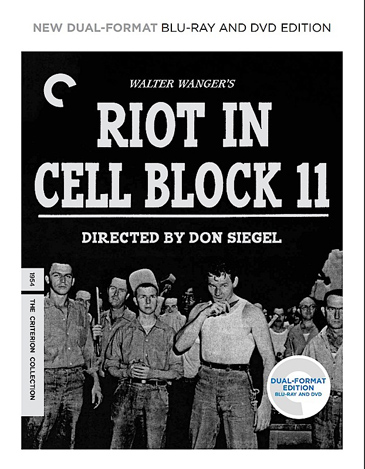CHICAGO – Patrick McDonald of HollywoodChicago.com appears on “The Morning Mess” with Dan Baker on WBGR-FM (Monroe, Wisconsin) on March 21st, 2024, reviewing the new streaming series “Manhunt” – based on the bestseller by James L. Swanson – currently streaming on Apple TV+.
Blu-ray Review: Dated ‘Riot in Cell Block 11’ is Beautifully Filmed
CHICAGO – The Criterion Collection has added “Riot in Cell Block 11” (1954) to their stellar Blu-ray family, and the transfer is absolutely gorgeous, especially if you’re an admirer of the stark cinematography of the late black & white film era. Although dated, it still packs a gritty wallop.
 Rating: 3.5/5.0 |
Directed by Don Siegel – best known for “Invasion of the Body Snatchers” (1956) and “Dirty Harry” (1971) – this prison riot film is framed as a cautionary tale regarding the conditions of prisons in the mid-1950s. Packed with noir beauty, the tick-tick-tick of the tensions in the film underscore the use of shadow and light. Shot in Folsom Prison in California, Siegel makes great use of the weird perspectives of long hallways and old timey prison walls. Some of the corny dialogue and hey-you-mugs interplay is silly in the modern era, but I’m sure the adventurous folks who saw this at the time were transfixed.

A Tense Moment For the ‘Riot in Cell Block 11’
Photo credit: The Criterion Collection
Cell Block 11 in a section in an unnamed prison that is a powder keg, containing the worst of the worst for both unbalanced and criminal felons. Prisoner Dunn (Neville Brand) is fed up, and plots a guard ambush that turns into an uprising. The riot in Cell Block 11 is underway, and prisoners like Crazy Mike (Leo Gordon), The Colonel (Robert Osterioh) and Monroe (Paul Frees) negotiate with Warden Reynolds (Emile Meyer) and the Governor’s representative, Commissioner Haskell (Frank Faylen). There are demands to be met, and hostages to be freed.
One of the true wonders of The Criterion Collection is the care they take to transfer the original film to Blu-ray projection. This silver toned black & white film probably never looked better, considering 1950s technology versus the high definition televisions of today. Director Siegel’s use of deep focus, black shadows and the strange beauty of the prison setting is a treat for the film art. This story could actually be watched without the sound and still be enjoyable, because of the scenic and cinematographic design.
 Dual Format Blu-ray & DVD of ‘Riot in Cell Block 11’ Photo credit: The Criterion Collection |
What was cutting edge in the 1950s, however, doesn’t translate well into today’s understanding. The producer of this film, Walter Wanger, actually did prison time and made the film in reaction to the appalling conditions he witnessed. There seems to be a conflict of morality in the final product, as the “authorities” – personified by Warden Reynolds and Commissioner Haskell – are given as much weight as the maligned prisoners. The message seems to be “yes, these conditions are appalling, but in the end these are hardened prisoners.” That conflict in the overall point-of-view weakens the thesis.
The acting is great in the film, and 1960s TV fans will get a treat seeing some of their later favorites with roles in this one – Alvy Moore (Gator) from “Green Acres,” William Schallert (Reporter) from “The Patty Duke Show” and the cartoon voiceover legend Paul Frees as Monroe (he voiced Boris Badenov on “The Bullwinkle Show,” among hundreds of other cartoon characters). Emile Meyer is the perfect warden, three years away from his classically cynical role as Harry Kelso in “Sweet Smell of Success.”
As usual, The Criterion Collection adds a treasure trove of extras with the film, including a standard DVD back-up in the Blu-ray package. Each disk contains expert commentary, excerpts from Don Siegel’s memoir – read by his son Kristoffer Tabori – and a NBC radio documentary from a 1953 series “The Challenge of Our Prisons.” The accompanying booklet has essays and articles from Producer Walter Wagner and filmmaker Sam Peckinpah.
The United States has the highest incarceration per capita of any Western nation, and with that large prison population the issue of conditions are still on the table, 60 years after “Riot in Cell Block 11.” Yet another addition to the everything-old-is-new-again file warehouse.
 | By PATRICK McDONALD |



The film hits upon the idea
The film hits upon the idea in the 1950’s that the prison system should punish instead of rehabilitate. It is an excellent example of prison life on the cusp of the rehabilitation era.